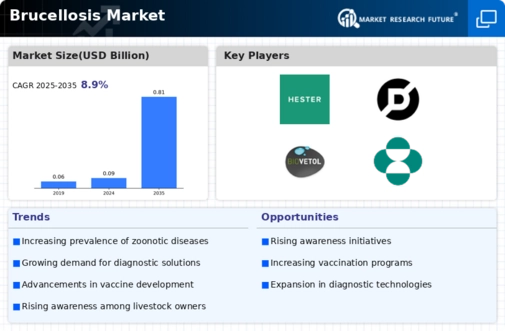Market Analysis
In-depth Analysis of Brucellosis Market Industry Landscape
The bacterial disease brucellosis, which may be spread from animals to people, has garnered interest in worldwide healthcare. Multiple factors interact closely to form Brucellosis market dynamics. These variables affect illness prevalence, diagnosis, treatment, and prevention. Global Brucellosis prevalence and incidence information underpins market dynamics. Livestock-intensive regions sometimes have higher infection rates. This is because humans and animals are so near in these areas. Thus, brucellosis-related healthcare therapies are desired. Diagnostics technology has greatly changed the sector. Combining serological testing with molecular and imaging methods improves detection accuracy and speed. Diagnostic tool markets change, affecting investments and research. Antibiotics remain the best Brucellosis prevention method. However, drug-resistant strains are changing market dynamics. Innovative formulations and combination medications are being studied by the pharmaceutical industry to enhance therapeutic effects and boost competition. Experimental formulations and combination medicines are being studied. Vaccine research is crucial to the business. The lack of a universally recognized human vaccine presents several obstacles and possibilities. In a competitive market, vaccine development businesses may dominate their rivals if regulatory bodies approve a successful vaccine. The regulatory framework greatly affects Brucellosis market dynamics. The mechanism used to approve diagnostic tests, treatments, and immunizations affects healthcare solutions' accessibility and market time. Due to legislative changes, manufacturers must meet the highest standards to protect people. Public awareness and education campaigns greatly impact market dynamics. Brucellosis awareness increases the need for prevention, early diagnosis, and effective treatment. Healthcare, government, and non-governmental groups' influence on public opinion benefits market dynamics. International cooperation and research funding are needed to combat Brucellosis. The partnership between pharmaceutical companies, research institutions, and governments impacts market dynamics. Knowledge sharing and resource sharing accelerate innovation. Cattle management affects Brucellosis. Sustainable and effective farming methods and strict animal health standards reduce the spread of pathogens from animals to humans. Disease-prevention-focused agriculture and animal husbandry affect market reactions. Telemedicine, digital health, and AI are changing brucellosis management. Remote monitoring and data analytics enhance diagnosis and treatment methods, which affects market dynamics in the digital age.







Leave a Comment